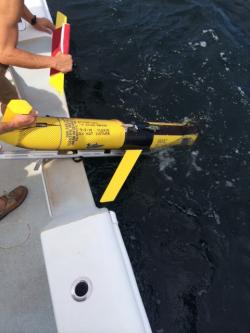Underwater Robots from Mote and USF Monitor Red Tide, Ocean Conditions in Gulf of Mexico
Waldo (top) and Bass (bottom) are two underwater robots launched by Mote Marine Laboratory and the University of South Florida, respectively, to monitor for Florida red tide and the ocean conditions that might affect it. (Photo credit: Capt. Greg Byrd/Mote Marine Laboratory)Two underwater robots deployed Friday by Mote Marine Laboratory and the University of South Florida (USF) are helping scientists learn about the offshore bloom of Florida red tide in the Gulf and the ocean conditions that might be affecting it.
The bloom – first reported offshore in a statewide update issued July 25 by the Florida Fish and Wildlife Conservation Commission (FWC) – is presently offshore of Hernando and Pasco Counties and appears to be 80 miles long, 50 miles wide and 40-90 miles offshore, according to satellite images. (See the latest update from FWC.)
While satellites capture the bloom’s surface appearance, only underwater robots and water sampling crews can verify the presence of the red tide algae, Karenia brevis, and detect the bloom beneath the surface. While scientists on boats can return water samples to the lab for more detailed analyses, robots can stay in the environment much longer, work in challenging weather and gather more data per mission.
Mote’s robot, an autonomous underwater vehicle (AUV) nicknamed “Waldo,” carries a Mote-designed red tide detector called an optical phytoplankton discriminator, nicknamed the “BreveBuster.” This instrument examines microscopic algae in the water and tells scientists how closely they resemble K. brevis. In addition, Waldo’s equipment measures salinity and temperature – two physical factors that can affect blooms and help scientists develop better short-term forecasts of bloom movement.
USF’s AUV, nicknamed “Bass,” collects physical and optical oceanography data, including chlorophyll from algae, oxygen levels and water clarity. Data from both AUVs will support mathematical modeling of the bloom for short-term forecasts developed by the USF-FWC Collaboration for the Prediction of Red Tides.
“The team effort between our AUVs is crucial,” said Dr. L. Kellie Dixon, manager of the Ocean Technology Program at Mote. “The bloom is large and one AUV would have difficulty surveying all of it within a reasonable amount of time. Each AUV also has its own strengths – Waldo is equipped to sense the presence of red tide, important for ground-truthing the satellite images, while Bass is designed to make deeper dives further offshore.”
Waldo is programmed to move south along the shallower eastern edge of the bloom while Bass is set to move south along the deeper, western edge. Both gliders will dive up and down, collecting data at various depths and then surfacing every few hours to send updates to scientists using satellite transmitters in their tails.
Results so far: Since deployment on Friday, Waldo has been patrolling to within about 40 miles from the Pasco/Hernando border and has found red tide at the surface and to depths of about 25 meters (82 feet) in areas where it was indicated by satellites. Bass has been transecting the outer portion of the bloom and has found elevated chlorophyll associated with the red tide into waters as deep as 40 meters (131 feet).
Both gliders indicate stratified (or layered) water, with warmer and fresher water on the surface, and an abrupt transition to colder, saltier water at mid-depth.
Where are Waldo and Bass?
The public can see Waldo’s position by visiting: http://coolcloud.mote.org and clicking “Glider Operations,” and Google Earth users can see Waldo and Bass’ positions at: http://ooma.marine.usf.edu/CROW/
Through underwater robot missions and other monitoring efforts, Mote and USF are partners in a major environmental monitoring collaboration called GCOOS – the Gulf of Mexico Coastal Ocean Observing System. GCOOS provides timely information about the environment of the U.S. portion of the Gulf of Mexico and its estuaries for use by decision-makers, including researchers, government managers, industry, the military, educators, emergency responders and the general public. Both gliders are reporting data to GCOOS’s Data Portal (http://gcoos.org/products/) in support of these efforts.
“In the future, we’d really like to compliment satellite imagery in the Gulf of Mexico with our underwater robots’ findings continuously, so that we can see what’s going on below the surface before a bloom initiates and starts killing fish and potentially impacting our coastlines,” said USF’s Chad Lembke, recently named leader of the Gulf Glider Task Team organized by GCOOS to assist in the coordination of glider efforts in the Gulf region. (“Glider” is another name for these AUVs or underwater robots.)
Red tide resources:
Statewide red tide updates and info from FWC: http://myfwc.com/redtide
Statewide updates in the HAB Bulletin from NOAA: http://tidesandcurrents.noaa.gov/hab/
Red tide information from Mote, including FAQs and the Beach Conditions Report: a monitoring system for red tide impacts on multiple Florida beaches: http://mote.org/news/environment-updates#RedTide
Learn about red tide on Facebook from this FWC-Mote page about Florida’s harmful algal blooms: www.facebook.com/flhabs
Latest model forecasts from USF-FWC Collaboration for Prediction of Red Tides at: http://cprweb.marine.usf.edu/
Founded in 1955, Mote Marine Laboratory & Aquarium is an independent, nonprofit 501(c)3 research organization based in Sarasota, Fla., with field stations in eastern Sarasota County, Charlotte Harbor and the Florida Keys. Mote has 24 research programs and a variety of initiatives dedicated to today’s research for tomorrow’s oceans with an emphasis on world-class research relevant to conservation and sustainable use of marine biodiversity, healthy habitats and natural resources. Mote’s vision includes positively impacting public policy through science-based outreach and education. Showcasing this research is The Aquarium at Mote, open from 10 a.m. to 5 p.m. 365 days a year. Learn more at www.mote.org.

